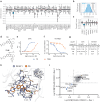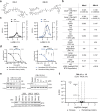DCAF1-based PROTACs with activity against clinically validated targets overcoming intrinsic- and acquired-degrader resistance
- PMID: 38177131
- PMCID: PMC10766610
- DOI: 10.1038/s41467-023-44237-4
DCAF1-based PROTACs with activity against clinically validated targets overcoming intrinsic- and acquired-degrader resistance
Erratum in
-
Author Correction: DCAF1-based PROTACs with activity against clinically validated targets overcoming intrinsic- and acquired-degrader resistance.Nat Commun. 2024 Aug 19;15(1):7109. doi: 10.1038/s41467-024-51317-6. Nat Commun. 2024. PMID: 39160182 Free PMC article. No abstract available.
Abstract
Targeted protein degradation (TPD) mediates protein level through small molecule induced redirection of E3 ligases to ubiquitinate neo-substrates and mark them for proteasomal degradation. TPD has recently emerged as a key modality in drug discovery. So far only a few ligases have been utilized for TPD. Interestingly, the workhorse ligase CRBN has been observed to be downregulated in settings of resistance to immunomodulatory inhibitory drugs (IMiDs). Here we show that the essential E3 ligase receptor DCAF1 can be harnessed for TPD utilizing a selective, non-covalent DCAF1 binder. We confirm that this binder can be functionalized into an efficient DCAF1-BRD9 PROTAC. Chemical and genetic rescue experiments validate specific degradation via the CRL4DCAF1 E3 ligase. Additionally, a dasatinib-based DCAF1 PROTAC successfully degrades cytosolic and membrane-bound tyrosine kinases. A potent and selective DCAF1-BTK-PROTAC (DBt-10) degrades BTK in cells with acquired resistance to CRBN-BTK-PROTACs while the DCAF1-BRD9 PROTAC (DBr-1) provides an alternative strategy to tackle intrinsic resistance to VHL-degrader, highlighting DCAF1-PROTACS as a promising strategy to overcome ligase mediated resistance in clinical settings.
© 2024. The Author(s).
Conflict of interest statement
M.S., X.L., F.M., T.Z., S.F., F.G., X.Li, F.S., S.G., T.-M.S., J.T., D.B., P.L., R.A.-R., B.Y.C., S.C., B.P., A.H., M.Schi, N.S., D.G., K.C., B.B.-P., M.M., M.N., R.M., M.H., J.A., E.A., G.H., L.T., A.V., M.K. are employees and shareholders of Novartis Pharma. M.R., C.R.T., T.R., R.M., and P.I. are former employees of Novartis. N.H.T. receives funding from the Novartis Research Foundation and is a scientific advisory board (SAB) member of Monte Rosa Therapeutics and an advisor to Zenith Therapeutics and Ridgeline. The remaining authors declare no competing interests.
Figures







References
Publication types
MeSH terms
Substances
Grants and funding
- 884331/EC | Horizon 2020 Framework Programme (EU Framework Programme for Research and Innovation H2020)
- 310030_301206/Schweizerischer Nationalfonds zur Förderung der Wissenschaftlichen Forschung (Swiss National Science Foundation)
- CRSII5_186230/Schweizerischer Nationalfonds zur Förderung der Wissenschaftlichen Forschung (Swiss National Science Foundation)
- KFS 4980-02-2020/Verein fur Krebsforschung (Association for Cancer Research)
LinkOut - more resources
Full Text Sources

